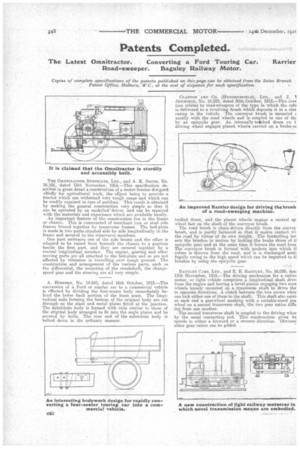Patents Completed.
Page 20

If you've noticed an error in this article please click here to report it so we can fix it.
The Latest Omnitractor. Converting a Ford Touring Car. Karrier
Road-sweeper. Baguley Railway Motor.
TELE OmNrraAcTon SYNDICATE, LID., and A. K. Slams, No. 16,101, dated 15th "November, 1915.—This specification describes in great detail a construction of a motor-tractor des:gned chiefly 'for agricultural work, the oliject being to provide a tractor which can withstand very rough usage and which can be readily repaired in case of accident. This result is obtained by making the general construction very simple so that it can he operated by an unskilled' driver, and can be repaired with the materials and experience which are available locally. An important feature of the construction lies in the frame or chassi›. This is constructed of merchant iron or steel side frames braced together by transverse frames. Thu -bed-plate is made in two parts situated side by aide longitudinally in the frame and secured to the transverse members.
One part embraces one of the side beams and the other is adapted to be raised from beneath the chassis to a position beside the first part, and they are secured together by a central longitudinal member. The engine, gearing and other moving parts are all attached to the bed-plate and so are not affected by vibration in travelling over rough ground. The construction and arrangement of the various parts, such as the differential, the mounting of the crankshaft, the changespeed gear and the steering are all very simple.
A. ITTBBERT, No. 14,645, dated 16th October, 1915.—The conversion of a Ford or similar car to a commercial vehicle is effected by dividing the four-seater body immediately behind the lower back portion of the front seats. The longitudinal rails forming the bottom of the original body are cut through on the slant and metal plates fitted at the junction. The substitute body is formed with rails similar to those of the original body arranged to fit into the angle plates and be secured by bolts. The rear end of the substitute body is bolted down in the ordinary manner.
CLAYTON AND CO, (HUDDRP.SYTYLD), LTD., and J. I 3E,SEMISON, No. 15,323, dated 30th October, 1915.--This inve tion relates to read-sweepers of the type in which the rein is delivered to a revolving brush which deposits it in a clos casing in the vehicle. The conveyor brush is mounted c axially with the road wheels and is coupled to one of ths by an epicyclic gear. An internally-toithed drum on t driving wheel engages planet wheels carried on a brake-co
trolled drum, and the planet wheels engage a central sp wheel fast on the shaft of the conveyor brush. The road brush is chain-driven directly from the convey brush, and is partly balanced so that it makes contact wi the road by virtue of its own weight. The tontrolling ley sets the brushes in motion by locking the brake drum of tl epicyclic gear and at the same time it lowers the road brus The conveyor brush is formed with pockets into which ti refuse is thrown from the road, and it is discharged tient] fugally owing to the high speed which can be imparted to ti brushes by using the epicyclic gear.
BAOULEY CABS. LTD., and E. E. BAGTLEY, NO. 16,030, dati 13th-November, 1915.—The driving mechanism for a railwi motor, or light vehicle comprises a longitudinal shaft drivi from the engine and having a bevel pinion engaging two croa wheels loosely mounted on a transverse shaft to-drive the in opposite directions. A clutch between the two crown whee can lock either one of them to the shaft. This shaft also carril at each end a gearwheel meshing with a suitable-sized gea wheel on a second transverse shaft, the two gear ratios dine ing from one another.
The second transverse shaft is coupled to the driving whee by the usual connecting rod. This construction gives by speeds in either a forward or a reverse .direction. Obvious] other gear ratios can be added.




















